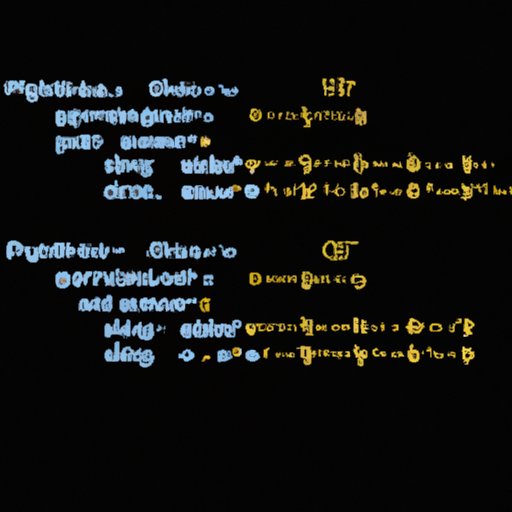Introduction
A procedure is a set of instructions or steps used to accomplish a task or solve a problem in computer science. Procedures are essential components in programming, as they help define the logic of a program and break down complex tasks into simpler ones. In this article, we will explore the definition of a procedure in computer science, provide an overview of different types of procedures used in computer science, and analyze how procedures are used in programming.
Explaining the Definition of a Procedure in Computer Science
To understand what a procedure is in computer science, it is important to first examine the definition of the term. According to the Oxford English Dictionary, a procedure is “a series of actions conducted in a certain order or manner.” In computer science, a procedure is a sequence of instructions that tells a computer to do something, such as perform a calculation or display information on the screen. Procedures are also known as subroutines, functions, methods, or programs.
How Does a Procedure Relate to Programming?
Procedures are closely related to programming, as they are used to define the logic of a program and break down complex tasks into simpler ones. A procedure typically contains a set of statements that are executed in a specific order, and can be reused multiple times within a program. For example, a procedure may contain code that calculates the area of a circle, which can be reused in any program that requires this calculation. By breaking down complex tasks into simpler ones, programmers can create efficient and well-structured programs.

Examining Different Types of Procedures Used in Computer Science
There are several different types of procedures used in computer science, including procedural programming languages, non-procedural programming languages, and data structures and algorithms. Let’s take a closer look at each type.
Procedural Programming Languages
Procedural programming languages are based on the concept of procedures. These languages use statements to specify what a program should do, and how it should do it. Examples of procedural programming languages include C, Pascal, and Fortran.
Non-Procedural Programming Languages
Non-procedural programming languages are not based on the concept of procedures. Instead, these languages use commands to specify what a program should do, without specifying how it should do it. Examples of non-procedural programming languages include SQL and Prolog.
Data Structures and Algorithms
Data structures and algorithms are used to organize and process data. They are often used in conjunction with procedural and non-procedural programming languages. Examples of data structures and algorithms include linked lists, binary trees, and sorting algorithms.

Analyzing How Procedures are Used in Programming
Now that we have examined different types of procedures used in computer science, let’s analyze how they are used in programming.
Benefits of Using Procedures
Using procedures in programming has several benefits. For one, procedures can help simplify complex tasks, making them easier to understand and debug. Additionally, procedures can make a program easier to maintain, as they can be reused multiple times within a program. Finally, procedures can help improve the performance of a program, as they can reduce the amount of code needed to accomplish a task.
Comparing and Contrasting Procedural and Non-Procedural Programming Languages
It is important to note that there are differences between procedural and non-procedural programming languages. As previously mentioned, procedural programming languages use statements to specify what a program should do, and how it should do it. On the other hand, non-procedural programming languages use commands to specify what a program should do, without specifying how it should do it. Thus, while both types of programming languages are used to achieve the same goal, they approach it in different ways.
Conclusion
In conclusion, a procedure is a set of instructions or steps used to accomplish a task or solve a problem in computer science. There are several different types of procedures used in computer science, including procedural programming languages, non-procedural programming languages, and data structures and algorithms. Furthermore, using procedures in programming has several benefits, such as simplifying complex tasks, making programs easier to maintain, and improving program performance. Therefore, procedures play an important role in computer science and programming.
(Note: Is this article not meeting your expectations? Do you have knowledge or insights to share? Unlock new opportunities and expand your reach by joining our authors team. Click Registration to join us and share your expertise with our readers.)
